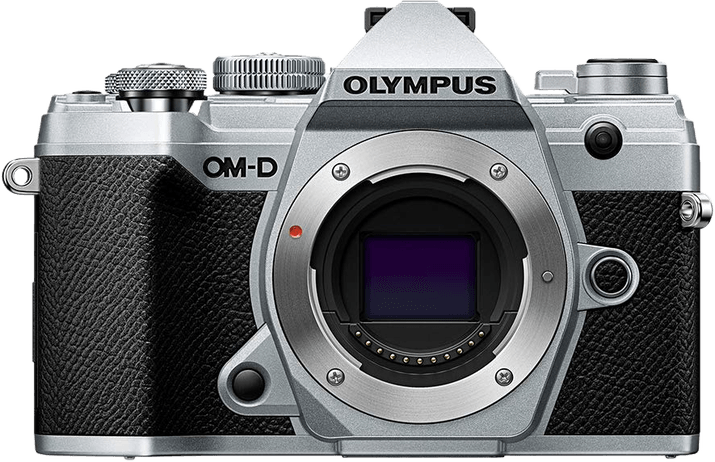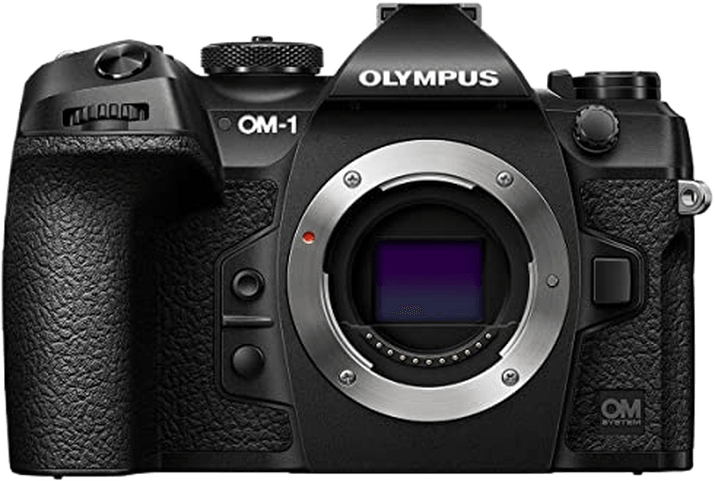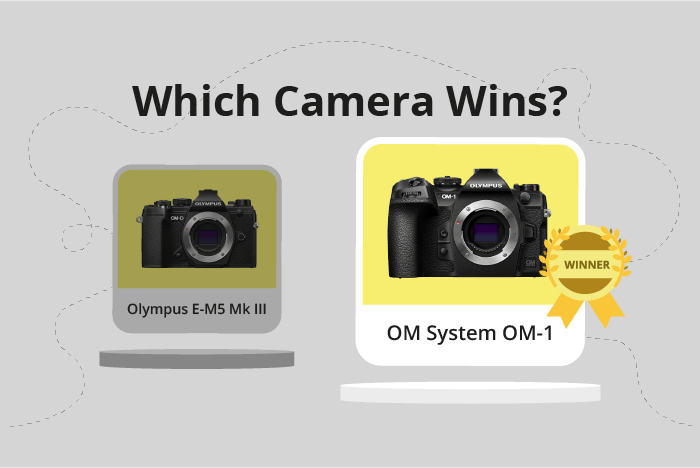Olympus OM-D E-M5 Mark III vs OM System OM-1 Comparison
Olympus OM-D E-M5 Mark III

Olympus OM System OM-1

The Olympus OM System OM-1 outperforms the Olympus OM-D E-M5 Mark III with a score of 73/100, compared to the latter’s 65/100. Both cameras are mirrorless, were announced in the 2010s, and share similarities in size and weight. The OM-1 is larger at 135 x 92 x 73mm and heavier at 599g, while the E-M5 Mark III measures 125 x 85 x 50mm and weighs 414g.
The OM-1’s higher score reflects its superior performance and features. However, the E-M5 Mark III has its advantages, such as its lower launch price of $1199 compared to the OM-1’s $2199. This makes the E-M5 Mark III a more budget-friendly option for those seeking a capable mirrorless camera.
Taking into account the scores and specifications, the OM-1 proves to be the better camera. However, potential buyers should also consider their budget and specific needs before making a decision.
Olympus OM-D E-M5 Mark III vs OM System OM-1 Overview and Optics
The Olympus OM System OM-1 surpasses the Olympus OM-D E-M5 Mark III in optics with a 9-point difference, scoring 69/100 compared to 60/100. Both cameras share several key specifications, including 20-megapixel resolution, Micro Four Thirds sensor size, Micro 4/3 lens mount, and built-in image stabilization.
The OM-1’s superiority in optics is primarily due to its advanced Stacked CMOS sensor and powerful TruePic X Dual Quad Core Processor. This combination results in a significantly higher DXOMARK sensor score of 85, compared to the E-M5 Mark III’s 55. The OM-1’s enhanced sensor technology allows for better image quality and low-light performance.
Additionally, the E-M5 Mark III has a faster shooting speed of 30 frames per second, which is triple the OM-1’s 10 frames per second. This advantage enables the E-M5 Mark III to capture fast-moving subjects and action shots more effectively.
However, the OM-1’s slower shooting speed should not be disregarded entirely, as it may still be adequate for many photography scenarios. Moreover, the OM-1’s higher overall optics score indicates that its superior sensor quality and processing power outweigh its lower shooting speed in terms of overall image quality.
In the end, the Olympus OM System OM-1 emerges as the better option for photographers prioritizing image quality and low-light performance. The Olympus OM-D E-M5 Mark III, on the other hand, is the better choice for those needing a faster shooting speed for action photography. Both cameras offer strong features, and the final decision should be based on individual preferences and requirements.
Olympus OM-D E-M5 Mark III vs OM System OM-1 Video Performance
The Olympus OM-D E-M5 Mark III outperforms the Olympus OM System OM-1 in video capabilities, scoring 91/100 compared to the OM-1’s score of 83/100. Both cameras share some common specifications, such as a maximum video resolution of 4K and dimensions of 4096 x 2160. Additionally, both cameras have built-in time-lapse functionality.
The E-M5 Mark III’s higher score is due to its superior video frame rate, which reaches up to 120fps, allowing for smoother slow-motion footage. This feature gives the E-M5 Mark III an edge over the OM-1, which has a maximum video frame rate of 60fps. The faster frame rate in the E-M5 Mark III provides more versatility for capturing fast-moving subjects and creating professional-looking videos.
On the other hand, the OM-1 does not surpass the E-M5 Mark III in any video-related specifications. Its lower score reflects its limitation in video frame rate compared to the E-M5 Mark III. The OM-1 still offers solid video performance, but the E-M5 Mark III is the clear winner in this comparison.
Both cameras are excellent choices for photographers and videographers, but the Olympus OM-D E-M5 Mark III offers superior video capabilities, particularly in terms of maximum video frame rate. The OM-1 is a strong contender, but those seeking the best video performance should opt for the E-M5 Mark III.
Olympus OM-D E-M5 Mark III vs OM System OM-1 Features and Benefits
The Olympus OM-D E-M5 Mark III and the Olympus OM System OM-1 both have a feature score of 83/100. These cameras share several specifications, including a 3-inch screen size, 1040000-dot screen resolution, touchscreen, flip screen, and the absence of GPS. They also both support WIFI and Bluetooth connectivity.
The Olympus OM-D E-M5 Mark III is better in certain aspects. Specifically, it excels in its compact and lightweight design, making it a more portable option for photographers. Additionally, the E-M5 Mark III features a high-speed autofocus system and 5-axis image stabilization, which ensures sharp and blur-free images even in challenging shooting conditions.
On the other hand, the Olympus OM System OM-1 stands out for its retro design that pays homage to the original OM-1 film camera. This aesthetic appeals to photographers who appreciate a classic look. Furthermore, the OM-1 offers advanced computational photography features, such as Live ND and Starry Sky AF, which enhance creativity in various shooting scenarios.
While both cameras have impressive features, the Olympus OM-D E-M5 Mark III is more suitable for photographers who prioritize portability and image stabilization. In contrast, the Olympus OM System OM-1 caters to those who appreciate a retro design and advanced computational photography capabilities. Ultimately, the choice between these two cameras depends on individual preferences and specific photography needs.
Olympus OM-D E-M5 Mark III vs OM System OM-1 Storage and Battery
The Olympus OM System OM-1 outperforms the Olympus OM-D E-M5 Mark III in storage and battery, scoring 73 points compared to the latter’s 35 points. Both cameras share similarities in storage, accepting SD, SDHC, and SDXC memory cards, and offering USB charging capabilities.
The OM-1 surpasses the E-M5 Mark III with its dual memory card slots and compatibility with both UHS-I and II cards. Additionally, the OM-1 has a longer battery life of 530 shots, compared to the E-M5 Mark III’s 310 shots, and uses the BLX-1 battery type.
The E-M5 Mark III does not offer any particular advantages in storage and battery over the OM-1. Given the significant difference in their scores, the OM-1 proves to be the superior choice for photographers prioritizing storage capacity and battery life.
Olympus OM-D E-M5 Mark III vs OM System OM-1 – Our Verdict
Are you still undecided about which camera is right for you? Have a look at these popular comparisons that feature the Olympus OM-D E-M5 Mark III or the Olympus OM System OM-1:

